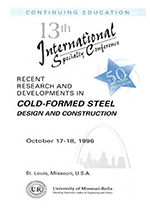Session Dates
17 Oct 1996
Abstract
A revision to the Canadian Standard (S136-94)[1] and the American Specification (AISI- 89)[2], in which the procedure to calculate the effective width of an edge-stiffened compressive flange is modified, has been proposed by Dinovitzer et al.[3]. The proposal involves a change of the equations for the flange plate buckling coefficients of Case II compressive elements, which eliminates a discontinuity in the effective width formulation. The modified local buckling procedure was compared with the current Canadian Cold Formed Steel Standard using a program of beam tests at the University of Waterloo[4] and data available in the literature[8,9, 10, 11,12]. Statistical results of the comparison indicate that the revised method is more accurate than current design standards and use of this procedure simplifies the current plate buckling equations. It is recommended that the Dinovitzer approach be adopted by the North American Design Standards.
Department(s)
Civil, Architectural and Environmental Engineering
Research Center/Lab(s)
Wei-Wen Yu Center for Cold-Formed Steel Structures
Meeting Name
13th International Specialty Conference on Cold-Formed Steel Structures
Publisher
University of Missouri--Rolla
Document Version
Final Version
Rights
© 1996 University of Missouri--Rolla, All rights reserved.
Document Type
Article - Conference proceedings
File Type
text
Language
English
Recommended Citation
Rogers, Colin A. and Schuster, R. M., "Interaction of Flange/edge - Stiffened Cold Formed Steel C - Sections" (1996). CCFSS Proceedings of International Specialty Conference on Cold-Formed Steel Structures (1971 - 2018). 4.
https://scholarsmine.mst.edu/isccss/13iccfss/13iccfss-session2/4
Interaction of Flange/edge - Stiffened Cold Formed Steel C - Sections
A revision to the Canadian Standard (S136-94)[1] and the American Specification (AISI- 89)[2], in which the procedure to calculate the effective width of an edge-stiffened compressive flange is modified, has been proposed by Dinovitzer et al.[3]. The proposal involves a change of the equations for the flange plate buckling coefficients of Case II compressive elements, which eliminates a discontinuity in the effective width formulation. The modified local buckling procedure was compared with the current Canadian Cold Formed Steel Standard using a program of beam tests at the University of Waterloo[4] and data available in the literature[8,9, 10, 11,12]. Statistical results of the comparison indicate that the revised method is more accurate than current design standards and use of this procedure simplifies the current plate buckling equations. It is recommended that the Dinovitzer approach be adopted by the North American Design Standards.



